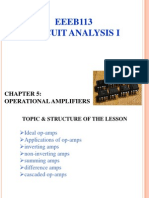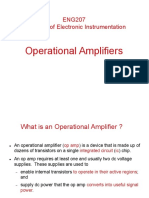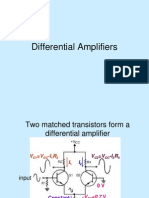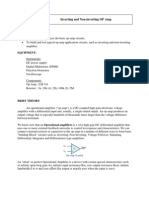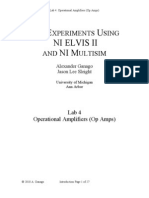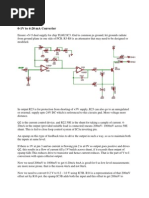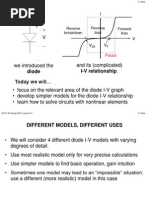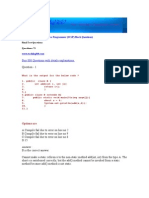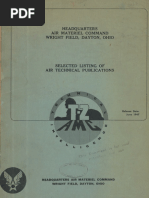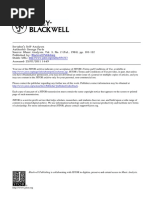Lec9 2003
Lec9 2003
Uploaded by
cassCopyright:
Available Formats
Lec9 2003
Lec9 2003
Uploaded by
cassOriginal Title
Copyright
Available Formats
Share this document
Did you find this document useful?
Is this content inappropriate?
Copyright:
Available Formats
Lec9 2003
Lec9 2003
Uploaded by
cassCopyright:
Available Formats
EECS 40 Spring 2003 Lecture 9
Copyright Regents of the University of California
S. Ross and W. G. Oldham
DIFFERENTIAL AMPLIFIER
Differential Amplifier V+ V + A V0 Ri
V0 = A( V+ V )
Circuit Model in linear region + V1 AV1 + Ro + V0
Differential
V0 depends only on difference (V+ V-)
V0
The output cannot be larger than the supply voltages, which are not shown. It will limit or clip if we attempt to go too far. We call the limits of the output Slope is A the rails.
upper rail
V+ V
lower rail
Can add negative feedback to perform an operation on input voltages (addition, integration, etc.): operational amplifier
EECS 40 Spring 2003 Lecture 9
Copyright Regents of the University of California
S. Ross and W. G. Oldham
AMPLIFIER ANALYSIS USING CIRCUIT MODEL To analyze an amplifier circuit, you can replace the amplifier with the circuit model, then make sure the output is within rails. Example: Voltage Follower
VIN
Circuit Model in linear region
Ri VIN
V1
AV1
Ro
V0
A Ri + R o Vo = VIN ( A + 1) Ri + Ro
V0
Vo AV1 V1 = Ro Ri V1 = VIN Vo
EECS 40 Spring 2003 Lecture 9
Copyright Regents of the University of California
S. Ross and W. G. Oldham
ANALYZING OPERATIONAL AMPLIFIER CIRCUITS: IDEAL ASSUMPTIONS For easier, approximate analysis of op-amp circuits: Rule 1: Assume A = Since Vo finite (limited by rails), Vp-Vn = 0 Rule 2: Assume Ri = No current flows into or out of input (+ and -) terminals Rule 3: Assume Ro = 0 But current can come out of/into amplifier output!
EECS 40 Spring 2003 Lecture 9
Copyright Regents of the University of California
S. Ross and W. G. Oldham
OPERATIONAL AMPLIFIER: HOW DOES IT DO THAT? Remember: current can flow out of/into op-amp output How? Op-amp is actually connected to positive and negative voltage supplies which set rails and deliver power to output load (via this output current) Utility of Voltage-Follower: If input voltage source cannot provide much power (current), VIN use voltage follower at output to drive a high power load
V0
EECS 40 Spring 2003 Lecture 9
Copyright Regents of the University of California
S. Ross and W. G. Oldham
ANALYZING AN OP-AMP: TIPS
Step 1: KVL around input loop (involves Vin and op-amp inputs) Use Rule 1: Vp-Vn = 0 Step 2: Find the current in the feedback path Use Rule 2: No current into/out of op-amp inputs Step 3: KVL around output loop (involves Vo and feedback path) Remember current can flow in/out op-amp output
EECS 40 Spring 2003 Lecture 9
Copyright Regents of the University of California
S. Ross and W. G. Oldham
EXAMPLE: INVERTING AMPLIFIER Feedback Path
VIN R1 R2 + V0
Input Loop
Output Loop
R2 Vo = VIN R1
EECS 40 Spring 2003 Lecture 9
Copyright Regents of the University of California
S. Ross and W. G. Oldham
ANOTHER EXAMPLE INVERTING SUMMING AMPLIFIER
R1 V1 V2 V3 R2 RF
R3
V0
RF RF RF V0 = V1 V2 V3 R1 R2 R3
EECS 40 Spring 2003 Lecture 9
Copyright Regents of the University of California
S. Ross and W. G. Oldham
IMPORTANT POINTS The amplifier output voltage does not depend on the load (what is attached to the output). The form of the output voltage (the signs of the scaling factors on the input voltages, for example) depends on the amplifier circuit layout. To change the values (magnitudes) of scaling factors, adjust resistor values. Input voltages which are attached to the + (non-inverting) amplifier terminal get positive scaling factors. Inputs attached to the (inverting) terminal get negative scaling factors. You can use these last two principles to design amplifiers which perform a particular function on the input voltages.
EECS 40 Spring 2003 Lecture 9
Copyright Regents of the University of California
S. Ross and W. G. Oldham
NON-INVERTING AMPLIFIER
R2 R1 VIN Vo
R2 VIN Vo = 1 + R1
EECS 40 Spring 2003 Lecture 9
Copyright Regents of the University of California
S. Ross and W. G. Oldham
INTEGRATING AMPLIFIER C VIN R
+
V0
1 Vo ( t ) = VIN (T )dT + VC (0) RC 0
You might also like
- AXIS200 /: Operating Instructions Laser Wheel AlignerDocument52 pagesAXIS200 /: Operating Instructions Laser Wheel AlignerOk PalaceNo ratings yet
- Natural Gas ProcessingDocument17 pagesNatural Gas ProcessingmohamedNo ratings yet
- LiftDocument12 pagesLiftRidwan WkNo ratings yet
- Lecture 9: Operational AmplifiersDocument8 pagesLecture 9: Operational AmplifiersSachin ShekhawatNo ratings yet
- Circuits Laboratory Experiment 9 Operational AmplifiersDocument22 pagesCircuits Laboratory Experiment 9 Operational AmplifiersSridhar JayaramanNo ratings yet
- Op AmpDocument74 pagesOp AmpACSVNo ratings yet
- OpAmp F10Document32 pagesOpAmp F10jaya1816100% (2)
- Lectures 16 To 18 - Op-AmpDocument19 pagesLectures 16 To 18 - Op-AmpAniketsingh MundlothNo ratings yet
- Lab 1 Operational AmplifiersDocument12 pagesLab 1 Operational AmplifiersChris BrownNo ratings yet
- Dependent Voltage and Current SourcesDocument8 pagesDependent Voltage and Current SourcescassNo ratings yet
- Open Loop Amplifier Model and Parameters: The ComparatorDocument1 pageOpen Loop Amplifier Model and Parameters: The Comparatoriky77No ratings yet
- Electronics For BEd. 4Document65 pagesElectronics For BEd. 4YohanesNo ratings yet
- Linear Amplifiers and Opamps: I + Av - + V I Z V Z R RDocument19 pagesLinear Amplifiers and Opamps: I + Av - + V I Z V Z R RAnimesh GhoshNo ratings yet
- Expt 4Document14 pagesExpt 4Krunal PatelNo ratings yet
- Operational Amplifier - Wikipedia, The Free EncyclopediaDocument24 pagesOperational Amplifier - Wikipedia, The Free EncyclopediaMadhu Krishna KarthanNo ratings yet
- Lab 4 - Operational AmplifiersDocument13 pagesLab 4 - Operational AmplifiersVinh PhamNo ratings yet
- Operational AmplifierDocument19 pagesOperational AmplifierTanvir Ahmed MunnaNo ratings yet
- New Microsoft Office Word DocumentDocument21 pagesNew Microsoft Office Word DocumentPankaj AttriNo ratings yet
- Chap4a OpAmpDocument37 pagesChap4a OpAmpAl AidenNo ratings yet
- Electronic-Device-lab-2-Operational AmplifiersDocument10 pagesElectronic-Device-lab-2-Operational AmplifiersVy NguyễnNo ratings yet
- PEEI - Expt-4 (OP-AMP)Document14 pagesPEEI - Expt-4 (OP-AMP)Harivony AndriamanantenaNo ratings yet
- SUMMING AND DIFFERENCEDocument9 pagesSUMMING AND DIFFERENCENYONGESA CephasNo ratings yet
- Operational Amplifier Lab Experiment: Dr. İsmail BayezitDocument3 pagesOperational Amplifier Lab Experiment: Dr. İsmail BayezitasdadsNo ratings yet
- EEEB113 Circuit Analysis I: Operational AmplifiersDocument39 pagesEEEB113 Circuit Analysis I: Operational AmplifiersMuhd RzwanNo ratings yet
- Instrumentation Amplifiers: EE 483 Week 4 - Spring 1998Document3 pagesInstrumentation Amplifiers: EE 483 Week 4 - Spring 1998ge_bdNo ratings yet
- FEEE Module 4Document28 pagesFEEE Module 4jthangelNo ratings yet
- Lecture 8 Basic Electronics EngineeringDocument68 pagesLecture 8 Basic Electronics EngineeringgatesategoNo ratings yet
- Opamp ApplicationDocument38 pagesOpamp ApplicationS.m. FerdousNo ratings yet
- Operational Amplifier (Phe-10)Document50 pagesOperational Amplifier (Phe-10)abhinavthedhimanNo ratings yet
- Note 4 Operational Amplifiers (Op-Amp) : Lecture Notes of ME 475: Introduction To MechatronicsDocument8 pagesNote 4 Operational Amplifiers (Op-Amp) : Lecture Notes of ME 475: Introduction To MechatronicszailekNo ratings yet
- 5 OpAmps CircuitsDocument59 pages5 OpAmps CircuitsDeepa ShreeNo ratings yet
- ContinueDocument3 pagesContinuesamanth0404No ratings yet
- Conditioning CircuitsDocument57 pagesConditioning CircuitsakozyNo ratings yet
- The "Operational" Amplifier: Eng - Ahmed HeskolDocument27 pagesThe "Operational" Amplifier: Eng - Ahmed HeskoladilNo ratings yet
- Operational AmplifierDocument25 pagesOperational AmplifierNeha KadamNo ratings yet
- Unit 1. B. Operational AmplifierDocument21 pagesUnit 1. B. Operational AmplifierRonald ConstantinoNo ratings yet
- OpampDocument36 pagesOpampjainamshahNo ratings yet
- Lic Lab ManualDocument89 pagesLic Lab ManualKALAIMATHI100% (1)
- Exp 02 CSE251 Fall 2024Document8 pagesExp 02 CSE251 Fall 2024sujailyunus84No ratings yet
- Dasar OpampDocument54 pagesDasar OpampAdri Muhaimin AfifNo ratings yet
- Exp No8Document9 pagesExp No8Mohd Syamsul Ramli100% (1)
- Lab4 OPAMDocument8 pagesLab4 OPAMkhoi26664No ratings yet
- Basic AppsDocument10 pagesBasic AppsHendra LeosuNo ratings yet
- 3LABO Ganago Student Lab4Document46 pages3LABO Ganago Student Lab4Rocio Deidamia Puppi HerreraNo ratings yet
- Lab 1 Operational Amplifiers: The Basics: Labview Demo 1.1: Op-Amp GainDocument8 pagesLab 1 Operational Amplifiers: The Basics: Labview Demo 1.1: Op-Amp GainSarath ChandraNo ratings yet
- Basic AppsDocument10 pagesBasic AppsajayganeshNo ratings yet
- Operational Amplifiers: What Is An Operational Amplifier?Document10 pagesOperational Amplifiers: What Is An Operational Amplifier?Ali MohamedNo ratings yet
- Introduction To Op-AmpsDocument25 pagesIntroduction To Op-Ampsyuwee yiiiNo ratings yet
- Operational Amplifiers (Op Amps) : Voltages. Symbol For An Op-AmpDocument8 pagesOperational Amplifiers (Op Amps) : Voltages. Symbol For An Op-AmpRaymond ScottNo ratings yet
- Bioelex Pr2Document25 pagesBioelex Pr2Eagle CoolNo ratings yet
- Inverting AmplifierDocument9 pagesInverting AmplifierKenzie WalipiNo ratings yet
- Converter 4 20maDocument19 pagesConverter 4 20mabnurkholis100% (2)
- Notes OpAmp F05 PDFDocument8 pagesNotes OpAmp F05 PDFmouneshskNo ratings yet
- OpampDocument37 pagesOpampArief PurwantoNo ratings yet
- Dasar OpampDocument54 pagesDasar OpampMaulana HidayatullahNo ratings yet
- 9 Op-Amps and TransistorsDocument36 pages9 Op-Amps and TransistorsthuanNo ratings yet
- Differential Amplifier - The Voltage SubtractorDocument6 pagesDifferential Amplifier - The Voltage SubtractorRing MasterNo ratings yet
- Op Amp ApplicationDocument24 pagesOp Amp ApplicationPutra ArisandyNo ratings yet
- Design of Electrical Circuits using Engineering Software ToolsFrom EverandDesign of Electrical Circuits using Engineering Software ToolsNo ratings yet
- Reference Guide To Useful Electronic Circuits And Circuit Design Techniques - Part 2From EverandReference Guide To Useful Electronic Circuits And Circuit Design Techniques - Part 2No ratings yet
- Reference Guide To Useful Electronic Circuits And Circuit Design Techniques - Part 1From EverandReference Guide To Useful Electronic Circuits And Circuit Design Techniques - Part 1Rating: 2.5 out of 5 stars2.5/5 (3)
- History of The Modern Periodic TableDocument41 pagesHistory of The Modern Periodic TablecassNo ratings yet
- Lec24 2003Document16 pagesLec24 2003cassNo ratings yet
- CMOS Means Complementary MOS: NMOS and PMOS Working Together in A CircuitDocument16 pagesCMOS Means Complementary MOS: NMOS and PMOS Working Together in A CircuitcassNo ratings yet
- Lec22 2003Document14 pagesLec22 2003cassNo ratings yet
- Lec20 2003Document20 pagesLec20 2003cassNo ratings yet
- Nmos (N-Channel Metal Oxide Semiconductor) Transistor: Eee Eee H H H H H HDocument16 pagesNmos (N-Channel Metal Oxide Semiconductor) Transistor: Eee Eee H H H H H HcassNo ratings yet
- Last Time : Reverse Breakdown Reverse Bias Forward BiasDocument15 pagesLast Time : Reverse Breakdown Reverse Bias Forward BiascassNo ratings yet
- Semiconductors: Chemical Structure: Si Si Si SiDocument12 pagesSemiconductors: Chemical Structure: Si Si Si SicassNo ratings yet
- Finding Voltages in A CircuitDocument8 pagesFinding Voltages in A CircuitcassNo ratings yet
- Food & Man Worksheet - With AnsDocument9 pagesFood & Man Worksheet - With Anszhangjoyce0110No ratings yet
- Ce Checklist 2018 2019Document2 pagesCe Checklist 2018 2019nonononowayNo ratings yet
- 2 Engineering Drawing PracticeDocument1 page2 Engineering Drawing PracticeAduchelab AdamsonuniversityNo ratings yet
- 3a KNN PDFDocument26 pages3a KNN PDFjithuNo ratings yet
- Math Worksheet Grade 1 RevisiDocument3 pagesMath Worksheet Grade 1 Revisianisasimamora19No ratings yet
- Experiment 1 Term 1 PDFDocument2 pagesExperiment 1 Term 1 PDFAsha AroraNo ratings yet
- Chapter 10 Haloalkanes and HaloarenesDocument19 pagesChapter 10 Haloalkanes and HaloarenesSujithNo ratings yet
- Trends in Mechanical and Biomedical Design: Esther Titilayo Akinlabi P. Ramkumar M. Selvaraj EditorsDocument973 pagesTrends in Mechanical and Biomedical Design: Esther Titilayo Akinlabi P. Ramkumar M. Selvaraj EditorsAttila NagyNo ratings yet
- SCJP 1.6 DumpDocument55 pagesSCJP 1.6 DumpMohanraj N100% (1)
- MMM15 Part 3 - Moderation PDFDocument20 pagesMMM15 Part 3 - Moderation PDFSana JavaidNo ratings yet
- On The Drying Behavior of Natural Oils Used For Solid Wood FinishingDocument9 pagesOn The Drying Behavior of Natural Oils Used For Solid Wood FinishingHarjaberht JimenezNo ratings yet
- Hi Pulse LiebertDocument102 pagesHi Pulse LiebertJose LuisNo ratings yet
- OH WWWDocument46 pagesOH WWWEduardCraciunNo ratings yet
- PWM Boost Converter PDFDocument12 pagesPWM Boost Converter PDFAnonymous wSgOVLfn6BNo ratings yet
- CH 5 RCC SlabDocument76 pagesCH 5 RCC SlabAmanGargNo ratings yet
- CH - 4 - Quadratic EquationsDocument10 pagesCH - 4 - Quadratic EquationsBITI Education Pvt. Ltd.No ratings yet
- Aditya Birla Group - Interview QuestionsDocument11 pagesAditya Birla Group - Interview QuestionsAbhay RajputNo ratings yet
- Alg 1 Systems Worksheet Practice PDFDocument2 pagesAlg 1 Systems Worksheet Practice PDFRyan WilsonNo ratings yet
- Variability and Heritability in M3 Mutants of Vicia faba LDocument3 pagesVariability and Heritability in M3 Mutants of Vicia faba LInternational Journal of Innovative Science and Research TechnologyNo ratings yet
- NS, PF (Service Kit Catalogue)Document8 pagesNS, PF (Service Kit Catalogue)nicolasNo ratings yet
- January 2021 QPDocument28 pagesJanuary 2021 QPNajmul AktherNo ratings yet
- Tutorial MS Project Lab 1,2,3,4,5Document36 pagesTutorial MS Project Lab 1,2,3,4,5hamza razaNo ratings yet
- Blank For Solenoid AssemblyDocument26 pagesBlank For Solenoid AssemblyJoseph AlcanseNo ratings yet
- Perle - Scriabin's Self AnalysesDocument23 pagesPerle - Scriabin's Self AnalysesJuan David MancoNo ratings yet
- PE MCQ Bank Unit 1 To 4Document20 pagesPE MCQ Bank Unit 1 To 4Shakura NishantNo ratings yet
- First Quarter Summative Test Mathematics 9: InstructionsDocument4 pagesFirst Quarter Summative Test Mathematics 9: InstructionsJaninne Villa del ReyNo ratings yet
- Class 4 Earth and UniverseDocument2 pagesClass 4 Earth and UniverseSuganthi AravindNo ratings yet























